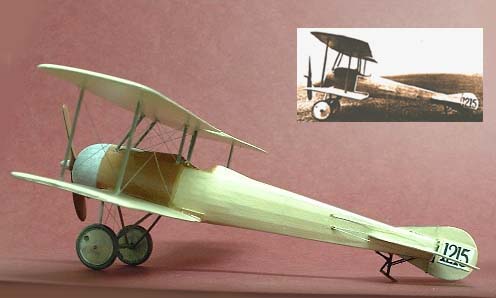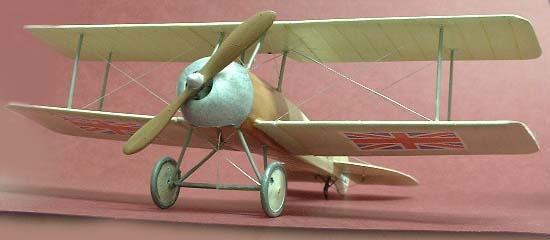

In 1909 the publisher of the New York Herald, James Gordon Bennett, offered a trophy and a prize of £1000 (in those days a sum in excess of $4000) for the highest spead attained by an aircraft over a defined course. This international competition was to be held annualy and may be considered a landplane equivalent to the water based Sheider Trophy race. Having tasted success in the Schneider race of April 1914 no doubt Sopwith hoped for a similar outcome in the Gordon Bennett trophy later that same year.

Two aircraft were prepared for the race; one was clearly a modified Tabloid, but the other was a radical redesign having only the outer wing panels in common with its stable mate. The war ensured that the 1914 trophy race did not take place. Despite its rakish appearance the Sopwith design was not as fast as the 1913 winner and it is doubtful that it would have done well in the competition.
Both aircraft were pressed into service with the RNAS, but only the more convenional of the two actually wenyt to war. Marked 1214 it was fitted with Morane deflector airscrew and armed with a Lewis gun. The other, the subject of the model, apparently remained on home establishment; although one photograph does show that it carried union flag markings under each lower wing.
A classic one-off the Sopwith Gordon Bennett racer is probably by most definitions obscure. So why model it? Well, why not? As far as I know there are are only three photographs of this aeroplane, and one of those so heavily retouched as to be useless for modelling purposes. But there is something about those racy lines. The Sopwith Cook Up was the spur I needed. Whos ever idea that was, thank you.

As scratchbuilds go this isn't quite as simple as it gets, but it's an interesting little project with just enough in the way of a challenge. The fuselage starts as a basic box and is then skinned. I skinned the front and rear portions seperately. The front end was no problem, but the back end involved a lot of trail and error with note paper before committing to plastic. There then followed more trial and error as marking the stringer detail causes the plastic to stretch and distort, but it's all part of the fun. The cowling was push molded using balsa male and female molds in the old fashioned way. Wings are parallel chord and unencumbered by control surfaces, this is a wing warper folks No, the only real problem was the absence of a drawing.
Drawing and model evolved to-gether, constantly checking one against the other and the two reference photographs. The only known dimensions are the span and chord of the outer wing panels, so hopefully intelligent guesswork was employed in liberal ammounts. The cowling dimensions can be estimated from the known diametre of the engine, other details are rather more speculative. The tailplane appears larger than the standard Tabloid component (which makes sense given that this is what we would now term a "pylon racer") and I have based it on contemporary Sopwith designs, notably the Folder seaplane which was going through the shop at about the same time. The structural detail shown was arrived at by the same method. In the only reference picture where it is visible the tail skid is in deap shadow, but it is of the pylon type similar to that fitted to the SS3 scout of 1915. The interplane struts, absense of stagger, and wing gap are also remeniscent of the SS3.
Click on image to enlarge As will be seen from even a cursory glance I am no draughtsman, so, for what it's worth, here it is for your perusal. Done with a school ruler and pen, so be gentle with me. And if you have any information which would help improve things do please contact me. Is there a full set of demensions out there someplace? On the other hand, if it turns out you have the most beautiful drawing, done by Arthur Granger or some-such in 1978, please keep it to yourself. Cheers.